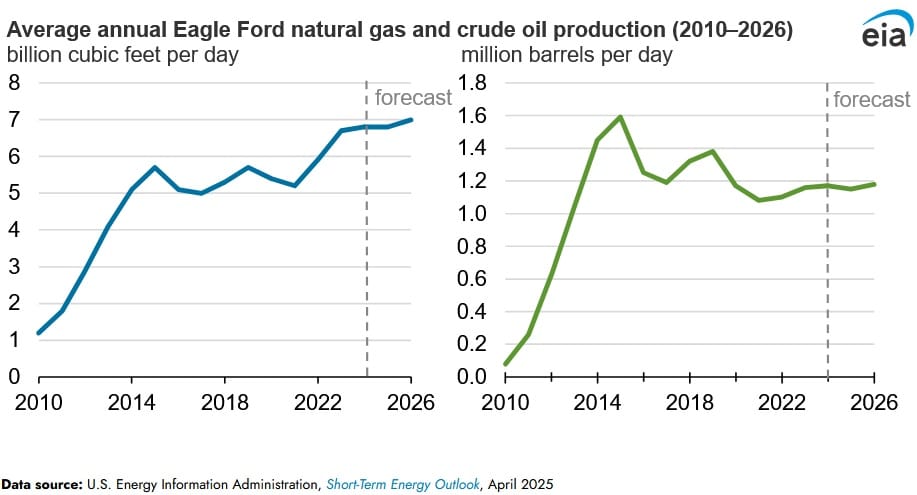Eagle Ford Natural Gas Production Forecast to Increase During 2025 & 2026: EIA

U.S. annual natural gas production from the Eagle Ford region is expected to increase from 6.8 billion cubic feet per day (Bcf/d) during 2024 to 7.0 Bcf/d in 2026, according to an April 14 report published by the U.S. Energy Information Administration. The growth in natural gas production can be attributed to forecasts of higher natural gas prices over the 2025 and 2026 period and growing demand for liquefied natural gas (LNG) exports.
The agency projects the Henry Hub price to average about $4.30/ million British Thermal Units (MMBtu) during 2025 and nearly $4.60/MMBtu during 2026, having average $2.20/MMBtu in 2024. The higher price is expected to financially incentivise the Eagle Ford region to produce natural gas. In contrast, oil production in the Eagle Ford has been close to 1.1 million barrels per day (b/d) since 2020, and the agency projects production to be in a similar region through 2026.
U.S. natural gas demand is forecast to increase by four percent to 116 Bcf/d during 2025. The increase is led by an 18 percent increase in exports and a nine percent rise in residential and commercial consumption for space heating. The increase in natural gas exports is driven primarily by an increase in LNG exports as two new LNG export facilities increase operations.
The Eagle Ford play accounts for 5.5 Bcf/d or 73 percent of the region’s natural gas production. Since 2020, natural gas production from the play has increased by 0.5 Bcf/d or 10 percent. The Austin Chalk play accounts for 1.8 Bcf/d or 23 percent of the region’s natural gas production. Since 2020, the play is the fastest growing in the region, with natural gas production nearly increasing by threefold (1.1 Bcf/d).
This increase in natural gas production with stable oil production in the Eagle Ford region is a result of increasing gas-oil ratios. As more oil and natural gas are produced, pressure within the reservoir declines, allowing more natural gas relative to oil to be produced. Natural gas production from the Eagle Ford play has increased over the last decade, as hydraulic fracturing and horizontal drilling has permitted operators to access and extract more crude oil and natural gas from tight formations. Associated natural gas production, which is natural gas produced from oil wells mainly has increased significantly from this tight play.
EnerKnol Pulses like this one are powered by the EnerKnol Platform—the first comprehensive database for real-time energy policy tracking. Sign up for a free trial below for access to key regulatory data and deep industry insights across the energy spectrum.
ACCESS FREE TRIAL